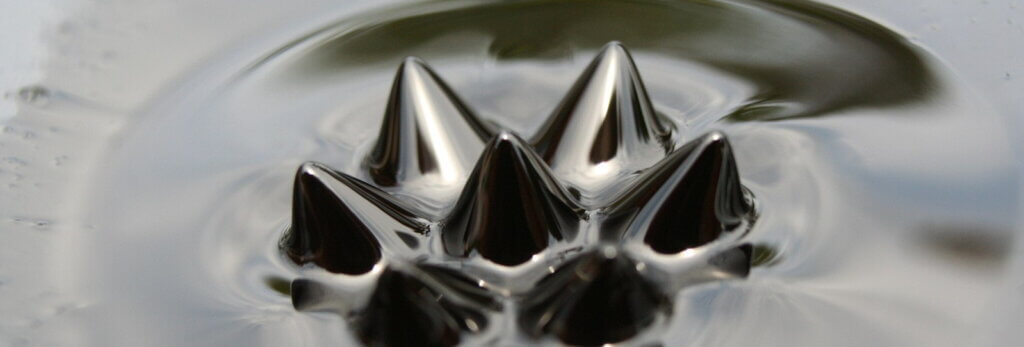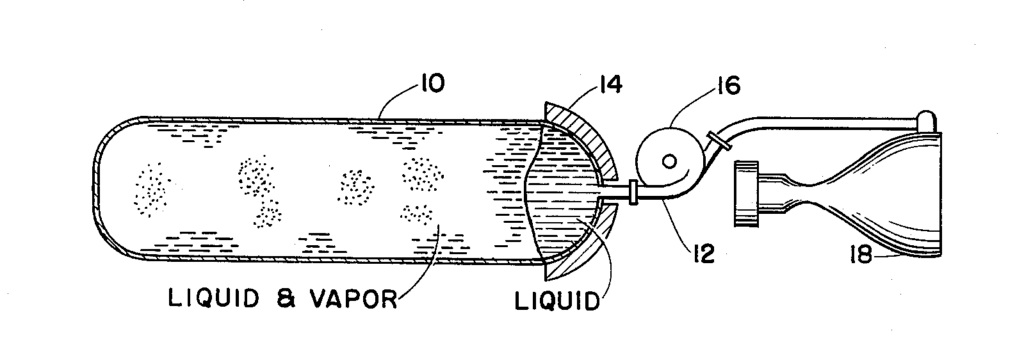A ferrofluid is a liquid that becomes highly magnetised in a magnetic field. The field can come from a magnet or electrical introduced from a coil. The most known feature of the ferrofluid is the distinctive shape in presence of a magnet. The fluid forms spikes and this is caused by the need to find the most stable shape in order to minimize the total energy of the system. This effect when the fluid forms a regular pattern of peaks and valleys is known as the Rosensweig or normal-field instability.
Ferrofluids are composed of nanoscale ferromagnetic particles suspended in a solution, usually water, oil or a solvent like kerosene forming a mixture where the particles are dispersed in the fluid forming a colloidal fluid. The surfactant, like often oleic acid, helps to stop the particles from clumping together in the liquid.
A typical composition would be 5% magnetic particles, 10% surfactant and 85% carrier fluid.
Nanoscale ferromagnetic particles
Ferrofluids uses particles that are on the nanoscale, with a diameter of 10 nanometers or less. The particle size has to be small enough to allow them to float around in the solution and evenly dispersed through the liquid. This is done by the random motion of particles, Brownian motion.
The magnetic response comes from the material that often are different iron compounds like magnetite (Fe 3O4).

Surfactant
The surfactant is used to keep the magnetic nanoparticles to clump together in the solution. They work by creating a layer around the particle which will repel the other coated particles, using the surfactant’s van der Waals force. The charge created around the particle makes it repel other charged, coated particles, as they have the same charge.
Who invented ferrofluid
The engineer Steve Papell invented the first ferrofluid in the 1960s. The goal was to create liquid rocket fuel that could be drawn toward a fuel pump in a weightless environment by applying a magnetic field.

What is the liquid in ferrofluid?
The liquid in ferrofluid is often a stable oil like kerosene. The oil is used to suspend the tiny magnetic fragments of iron with a surfactant to prevent clumping. The surfactant used is often oleic acid.
What is ferrofluid used for?
Ferrofluid is used in many industrial applications, like in rotary seals and shafts to reduce friction in motors, dampen vibrations, as a contrast agent for magnetic resonance imaging (MRI) and heat transfer in motors to name a few.
Ferrofluid has become increasingly popular in hub motors of electric bicycles and also the Onewheel to help transport the heat away from the stator. The best-known company is Statorad, with new companies entering the field like Armor-Dilloz and their ArmorChilloz FluxFluid.
How to make ferrofluid at home
In an industrial application, the liquid used is usually a stable oil carrying iron fillings or iron-containing nanoparticles. You can easily make a ferrofluid at home with some common household items and iron filings.
- Vegetable oil (sunflower/rapeseed oil)
- Iron filings
Pour a thin film of vegetable oil on a plate. Add iron filings into the oil and mix the two until they have become a thick, sludge-like material. Now you got ferrofluid, take a magnet and have fun!
Frequently Asked Questions about Ferrofluid
What happens if you touch ferrofluid?
It’s not recommended to touch ferrofluid as it’s considered a major skin irritant. The small particles usually are sharp and penetrate the skin layer causing irritation, these particles will be hard to wash out.
How do you get ferrofluid off your skin?
As ferrofluids of use oil as the liquid, there are a few options to get it off your skin. The best way is repeated washing with soap or detergent to remove the fluid. It’s advised to clean any spillage immediately with soap and water.
Is ferrofluid poisonous?
Depending on the solution used in the ferrofluid it can be poisonous. Always read the label and seek immediate medical attention if ingested. If the fluid aspirated into the lungs during ingestion it could cause severe pulmonary injury or death. Do not induce vomiting.
Why did NASA invent ferrofluid?
It was created by NASA as a way to move fuel in space where there is no gravity and instead used the magnetic properties of the fluid.
Word definitions
| Compound | A compound is a substance formed when two or more chemical elements unite. |
| Element | A building block of some larger structure. |
| Ferrofluid | (also magnetic fluid) A liquid that responds to a magnetic field because magnetic particles have been mixed into it. The prefix, ferro , means iron and refers to the fact that magnetic materials contain iron. |
| Iron | A metallic element that is common within minerals in Earth’s crust and in its hot core. |
| Liquid | A material that flows freely but keeps a constant volume, like water or oil. |
| Magnet | A material that usually contains iron and whose atoms are arranged so they attract certain metals. |
| Magnetic field | An area of influence is created by certain materials, called magnets, or by the movement of electric charges. |
| Particle | A minute amount of something. |
| Ferrite fluid | Sometimes ferrofluid is called ferrite fluid, ferrite is an iron oxide compound. |
| Colloidal fluid | A colloid is a mixture in which one substance consisting of microscopically dispersed insoluble particles is suspended throughout another substance. |
| Brownian motion | The random motion of particles in a liquid due to collisions which other molecules |


